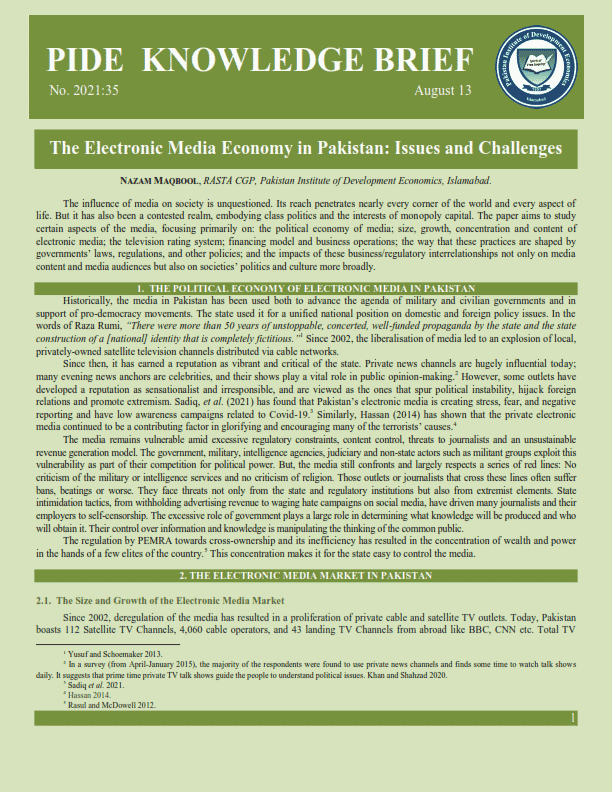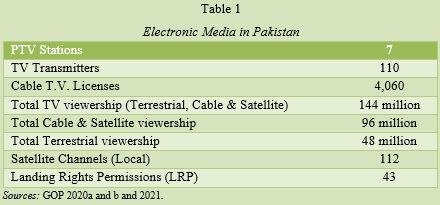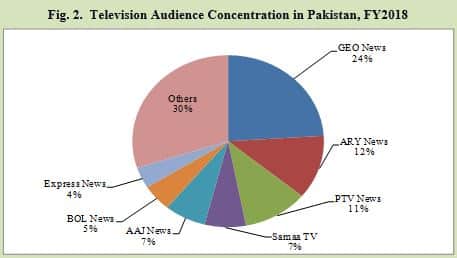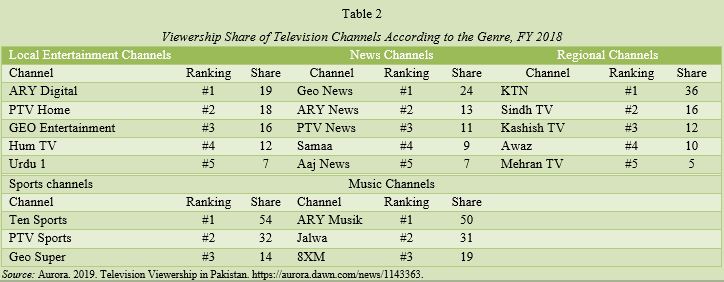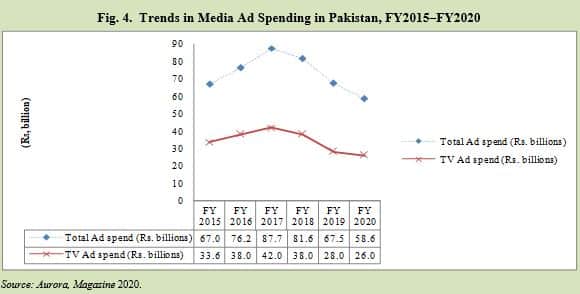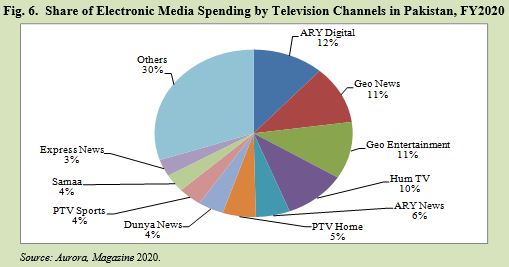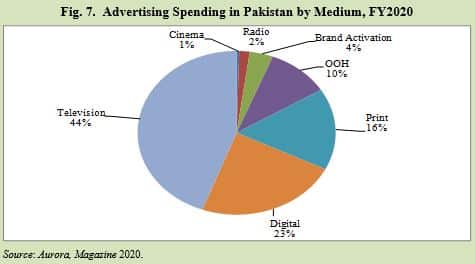
Pakistan Institute of Development Economics
- Home
Our Portals
MenuMenuMenuMenuMenuMenuMenu - ResearchMenuMenuMenuMenuMenuMenuMenu
- Discourse
- The PDR
- Our Researchers
- Academics
- Degree Verification
- Thesis Portal
- Our Portals
The Electronic Media Economy in Pakistan: Issues and Challenges
The Electronic Media Economy in Pakistan: Issues and Challenges
The influence of media on society is unquestioned. Its reach penetrates nearly every corner of the world and every aspect of life. But it has also been a contested realm, embodying class politics and the interests of monopoly capital. The paper aims to study certain aspects of the media, focusing primarily on: the political economy of media; size, growth, concentration and content of electronic media; the television rating system; financing model and business operations; the way that these practices are shaped by governments’ laws, regulations, and other policies; and the impacts of these business/regulatory interrelationships not only on media content and media audiences but also on societies’ politics and culture more broadly.
THE POLITICAL ECONOMY OF ELECTRONIC MEDIA IN PAKISTAN
Historically, the media in Pakistan has been used both to advance the agenda of military and civilian governments and in support of pro-democracy movements. The state used it for a unified national position on domestic and foreign policy issues. In the words of Raza Rumi, “There were more than 50 years of unstoppable, concerted, well-funded propaganda by the state and the state construction of a [national] identity that is completely fictitious.”[1] Since 2002, the liberalisation of media led to an explosion of local, privately-owned satellite television channels distributed via cable networks.
Since then, it has earned a reputation as vibrant and critical of the state. Private news channels are hugely influential today; many evening news anchors are celebrities, and their shows play a vital role in public opinion-making.[2] However, some outlets have developed a reputation as sensationalist and irresponsible, and are viewed as the ones that spur political instability, hijack foreign relations and promote extremism. Sadiq, et al. (2021) has found that Pakistan’s electronic media is creating stress, fear, and negative reporting and have low awareness campaigns related to Covid-19.[3] Similarly, Hassan (2014) has shown that the private electronic media continued to be a contributing factor in glorifying and encouraging many of the terrorists’ causes.[4]
The media remains vulnerable amid excessive regulatory constraints, content control, threats to journalists and an unsustainable revenue generation model. The government, military, intelligence agencies, judiciary and non-state actors such as militant groups exploit this vulnerability as part of their competition for political power. But, the media still confronts and largely respects a series of red lines: No criticism of the military or intelligence services and no criticism of religion. Those outlets or journalists that cross these lines often suffer bans, beatings or worse. They face threats not only from the state and regulatory institutions but also from extremist elements. State intimidation tactics, from withholding advertising revenue to waging hate campaigns on social media, have driven many journalists and their employers to self-censorship. The excessive role of government plays a large role in determining what knowledge will be produced and who will obtain it. Their control over information and knowledge is manipulating the thinking of the common public.
The regulation by PEMRA towards cross-ownership and its inefficiency has resulted in the concentration of wealth and power in the hands of a few elites of the country.[5] This concentration makes it for the state easy to control the media.
___________________________________
[1] Yusuf and Schoemaker 2013.
[2] In a survey (from April-January 2015), the majority of the respondents were found to use private news channels and finds some time to watch talk shows daily. It suggests that prime time private TV talk shows guide the people to understand political issues. Khan and Shahzad 2020.
[3] Sadiq et al. 2021.
[4] Hassan 2014.
[5] Rasul and McDowell 2012.
THE ELECTRONIC MEDIA MARKET IN PAKISTAN
2.1. The Size and Growth of the Electronic Media Market
Since 2002, deregulation of the media has resulted in a proliferation of private cable and satellite TV outlets. Today, Pakistan boasts 112 Satellite TV Channels, 4,060 cable operators, and 43 landing TV Channels from abroad like BBC, CNN etc. Total TV
viewership is 144 million, out of which 44 million are terrestrial while 96 million are cable and satellite viewership (see Table 1). At least 30 private TV channels exclusively broadcast news and current affairs programmes. The number of journalists in the same period ballooned from about 2,000 to over 20,000. Overall, the number of people associated with the media industry reached around 300,000.[6] There had been a cumulative investment of US$4-5 billion in the electronic media industry in Pakistan between 2002 and 2018. Moreover, new licenses issued by the Pakistan Electronic Media Regulatory Authority(PEMRA) would inject investment of approximately US$2-US$3 billion.[7] In Pakistan, 70 percent of the population own TV, with 100 million young and adult people watching 120 minutes every day, a move from 240 minutes per day in one decade. Among watched content, 70 percent of the content is entertainment, while 19 percent is news. This expansion in the media industry is attributed to improved economic fundamentals, increased per capita income, a rise in the consumer economy and an expanding advertising sector.
Many print media outlets operating before 2002 expanded to include TV news platforms. Almost all TV news channels maintain their websites, which contain news coverage from their platforms.[8] The media viewership in Pakistan is concentrated to four percent in newspaper, TV media, radio and news websites, and few owners control the market. Eighty percent of the market players who do not have viewership are surviving despite the market conditions.
However, the second half of 2018 brought bad news. The media industry started to decline. According to the Pakistan Federal Union of Journalists, at least 7,500 journalists and associated media employees have lost their jobs over the last two years. While almost every outlet has scaled back operations, more than two dozen publications and two TV channels have closed.[9] Partly affected by the outcome of the July 2018 elections and by an ailing economy coupled with the withdrawal of government subsidies and dwindling advertising revenue, even large and stable media groups were forced to shutter their publications and sack journalists.
2.2. The Concentration of Media Ownership and Audience
Media concentration in Pakistan, in terms of both ownership and audience share, is very high. It restricts sources of information available to the public, thereby limiting news and opinion diversity and pluralism. In terms of genre, foreign entertainment accounts for over half of the audience followed by News (19 percent) (see Figure 1). The top 8 owners (Jang Group, ARY Group, Express Group, the Government Group, Nawa-i-Waqt Group, Samaa Group, Dawn Group and Dunya Group) reach 68 percent of audience share across television, radio, print and online. All of them have a significant presence in more than one media sector.[10]
The Jang Group, the largest cross-media owner, controls over a third of the market among the top 40 media entities. The government is among the top three cross-media owners (Pakistan Television Corporation PTV, Pakistan Broadcasting Corporation PBC and the FM 101 stations).[11]
In the case of electronic media, the audience share for the top 4 TV channels in Pakistan (Geo News 24 percent, ARY News 12 percent, PTV News 11 percent and Samaa TV 7 percent) at the end of 2018 was 68.3 percent (see Figure 2). However, the situation varies considerably by genre for electronic media (see Table 2).
____________________________
[6] GOP 2021.
[7] GOP 2020b.
[8] Din 2020.
[9] Tariq 2021.
[10] Reporters without Borders 2019.
[11] Ibid.
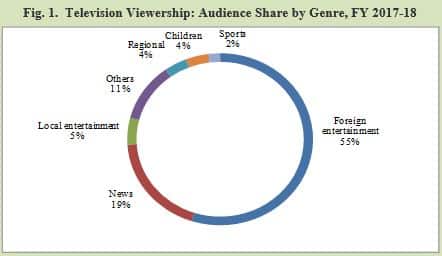 Source: Aurora. 2019. Television Viewership in Pakistan. https://aurora.dawn.com/news/1143363.
Source: Aurora. 2019. Television Viewership in Pakistan. https://aurora.dawn.com/news/1143363.
Note: Others include but are not limited to: movies (0.9 percent), music (0.8 percent), religious (0.7 percent)
and cooking channels (0.2 percent).
Source: Gallup Survey 2018: Media Consumption Data in Pakistan for Freedom Network.
https://pakistan.mom-rsf.org/en/ findings/findings/
2.3. Media Content
The debates and contents play an important role in how things are perceived, how people, policies, happenings, events, and changes are described, and whether they should be accepted or rejected by those who matter.
In the ten analysed talk shows during January 2021, PTI had the highest representation (42 percent), followed by PML (34 percent), PPP (20 percent) and JUF (3 percent). The topic most discussed was ‘Politics’ (72 percent), followed by ‘Health’ (4 percent), ‘Terrorism’ (3 percent), ‘Economy’ (2 percent), ‘Education (2 percent)’ and ‘Sports’ (2 percent). The dominance of politics at the cost of issues such as Health, Economy and Society, in general, is the source of concern. Of the 10 analysed talk shows, the percentage share of host speaking average time was 42 percent. It paints a bleak picture for giving time to guest speakers and anchors, hijacking the contents rather than being a regulator of the programme content.[12]
Subject specialists lack in TV debates. It should be 80 percent analysts and 20 percent politicians or spokesmen of political parties, which is the rule followed by well-reputed news channels like BBC and CNN. [13] In an analysis of selected prime talk shows, it was found that 73 percent of guests were political figures, 22 percent were analysts and only 5 percent were experts (see Figure 3).
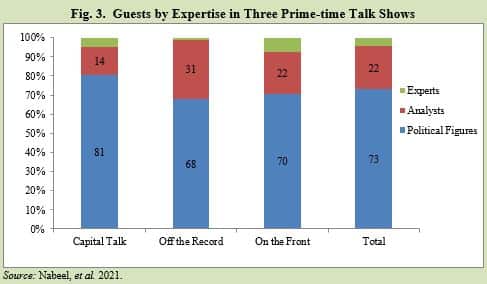
2.4. Television Rating Points (TRP) System
Five companies are licensed to conduct the electronic media rating business in the country. At the centre of the rating system is MediaLogic, which calculates overall TRPs daily using people-meters. It transfers information to PEMRA (after Supreme Court’s decision in 2018). The PEMRA then reassesses and releases results. Meters are fixed in 2,000 households (in over 30 cities) to assess the viewership patterns by age, gender and time. The sample size is just 2,000 households to represent the whole population, and hence an absurd system/ method is adopted for media ratings. The rating observed is used to award advertisements to the channels. The rating system is complex and lacks a proper and transparent mechanism. First, PEMRA’s control of rating marks a question on the independence of rating agencies.
Second, rating systems operate just like a mafia in which big players set the stage, lacking reasoning. The business model of rating companies is dependent on media houses that depend on the advertisers. The model has resulted in the monopoly of advertisers under the name Pakistan advertiser society. This society bounds the members to buy ratings from the approved rating company.
Third, ratings are just representations of urban Pakistan while it excludes rural areas, resulting in a disproportionate coverage of rural issues. Wahab (2011) highlighted that television talk shows maintain social order, exhibit only safe opinions and promote elite ideology.[14]
Fourth, cable operators can also exploit by placing a channel far below so that it gets watched less frequently.
Fifth, in 2015, a back and forth spat of MediaLogic with the Express Media Group involved accusations of bribery, extortion and unethical behaviours. A report in Aurora magazine says that there is “a serious trust deficit in people-meters and MediaLogic. The bulk of the controversy is related to two issues: erratic spikes and drops in ratings which have led people to believe that certain channels may be ‘buying’ the ratings; and the delay in the delivery of data (Medialogic delivers the data with a one-day time lag) leading to the conclusion that it might be doctored.”[15] Despite all this, the company continues to hold a virtual monopoly on the rating services business, something it claims is a good thing that encourages a uniform ‘data currency’.
_________________________________
[12] Gallup, Pakistan 2021.
[13] Qureshi 2020.
[14] Niazi 2019.
[15] Wahab 2011.
THE MEDIA AND THE ADVERTISING MARKET
The media industry advertisement has seen double-digit growth since the early 2000s in Pakistan. However, in FY2018 it went through an 11 percent decline in revenue (see Figure 4). While such a trend was as expected after around two decades of steady growth, the main trigger appears to be a decline in the public sector advertising budget. Pakistan’s electronic media is reliant on the public sector and commercial advertisement revenues for sustenance, while it gets nothing from distributors. Cable operators collect around Rs. 60 billion annually as a ‘subscription’ without a penny paying to the TV broadcasters (see Figure 5).[16] “The government uses the public sector advertisement (contributing 22-23 percent to the total media revenue) to impose its agenda on the media”, asserts Adnan Rehmat, an Islamabad-based media analyst.[17] As a result, many media outlets avoid negating politicians due to fear of losing advertising revenue.
Advertising expenditure in the country’s media industry increased at an annual rate of 23 percent between FY2002 and FY2011.[18] From Rs. 32 billion in FY2011, it reached a peak of Rs. 87.7 billion in FY2017 and then declined continuously to Rs. 58.6 billion in FY2020. The share of TV channels in total media advertisement revenues also decreased from 58 percent (Rs. 18.6 billion) in FY2011 to 44.4 percent (Rs. 26 billion) in FY2020. The rest goes to the digital formats, print, radio, Out of Home (OOH), etc (see Figures 6 and 7).
Based on their popularity among viewers, the top six channels grabbed 55 percent of the total television advertising spend in FY2020. ARY Digital, Geo News, Geo Entertainment and Hum TV topped the industry, each having over 10 percent share followed by ARY News and PTV News with over 5.5 percent share each, and Dunya News and PTV Sports with around four percent each.[19] The state television network, PTV, is directly subsidised through a ‘television fee’ addendum to every electricity bill in the country.
According to Aurora figures, of the top 10 advertisers (as product category) of TV media in FY 2018, the private sector, particularly the consumer goods and telecom industries, dominated both the news channels and the non-news channels.[20]
A slowing economy and declining money flow alone do not explain the media’s financial crisis. “The crisis is closely entwined with politics. The collapsing media economy is in a key part also the result of the overall shrinking space for media being engineered as part of the censorship of political dissent”, says Adnan Rahman.[21]
____________________________
[16] Baig 2020.
[17] Jamal 2018.
[18] Alam 2012.
[19] Aurora, Magazine 2020.
[20] Ibid.
[21] Rehman 2019.




THE REGULATORY AND LEGAL FRAMEWORK OF THE MEDIA ECONOMY
Besides a slash in government ad expenditures, the country’s regulatory system is also responsible for the media’s recent crisis. There is an absence of a modern regulatory framework that adequately covers audience share, circulation, revenue, distribution of share capital or voting rights, etc. It restricts diversity in ownership and opens it to political vulnerabilities and potential manipulation of the media market.
PEMRA is primarily a market regulatory authority. However, it is focused on content regulation and management and has become a censor board. The regulation infrastructure by default has resulted in the concentration of the media market. Until 2007, print media owners could not own electronic media due to a ban on cross-ownership. However, the removal of this ban in 2007 (PEMRA Amendment Act 2007) resulted in an undue concentration of audience and ad revenue in the media.
The structure of PEMRA also does not let the media industry generate revenue. Almost all of the electronic media revenue is generated through on-air advertising. Cable networks do not pay anything to the channels for transmitting their content. The TV channels do not charge any subscription fee from the end consumer either. Direct to home (DTH) is absent. As a result, a parallel economy has emerged that acts as an intermediary to distribute the media, like cable operators who earn 200 percent of the Pakistan TV advertisement economy instead of the content producers.
The authority has long been the enforcer of the government’s campaign of media censorship and repression. According to Rasul and Proffitt (2013), PEMRA has failed to promote local and diverse media and the government uses media regulation to hostile, pressurize and target media.[22] PEMRA has ordered television channels to shut down for airing criticism of the government, terminated live interviews of opposition leaders, blocked cable operators from broadcasting networks that aired critical programmes, and controlled advertisements for news channels in an attempt to silence them. The most recent example is the Dawn TV channel, whose advertisements were banned. Other curbs on media freedoms include the Prevention of Electronic Crimes Act passed in 2016, which provides strict online content regulations designed to tighten censorship. The federal cabinet approved the formation of the Pakistan Media Regulatory Authority, a single body to regulate all the media in 2019. The Pakistan Federal Union of Journalists released a statement afterwards calling the move in violation of the constitution.
IMPACT ON POLITICS
The growth of electronic media has helped build an active civil society and an informed citizenry in Pakistan. For instance, the media helped in spreading the anti-government wave, following Musharraf’s firing of the Chief Justice in 2007, resulting in his restoration. According to a survey conducted across Pakistan in 2018, nearly 68 percent of Pakistanis closely follow the local news while 51 percent believe the media is doing well in reporting the most important news. Similarly, 60 percent of Pakistanis believe the news organisations are doing well in reporting news accurately. While 58 percent agree that the media organisations are doing well at reporting about government leaders and officials.[23] Sarwar and Ali (2019) found that electronic media was the second most powerful tool (after interpersonal contact) to impact voters’ decisions during the 2013 General Elections in Punjab.[24]
With online news sources, news delivery is expected to be instantaneous. It has caused tension in journalism between being first and being right. With this pressure, standards of accuracy and fairness become more difficult to uphold. The TV debate shows lack quality analysis and good discussions. Politicians fighting every day end up giving no sense to the viewers. For instance, a popular TV personality bullied the late Punjab Province Governor Salman Taseer in a 2010 interview who was assassinated soon after. A senior leader from the ruling party once hurled a glass at a fellow guest during a TV talk show. Eijaz, et al. (2014)[25] found that in Pakistani media, we see cutthroat competition for TRP, sensationalism, yellow journalism, immature and unprofessional workers, unethical content, substandard infotainment, more statements.
Journalism has become a hostage to corporate culture and ratings. As a result, they cater more to market requirements rather than ethics. “In Pakistan, we have a very unusual situation—a flawed rating system”, “you have 40-odd news channels competing with each other. The minute one channel does something different or reports something, it gives them ratings”, says Kamal Siddiqi, director of the Centre of Excellence in Journalism[26] “An unpaid journalist would care more about his financial problems instead of concentrating on quality and doing efforts for freedom of the press”, says Mazhar Abbas. While the economic situation may silence some voices, few journalists will continue to assess and censure the government and its policies.
THE WAY FORWARD
“A free media is not only the backbone of a civilised society but also serves as the lungs of society that allow it to breathe freely”, says late I. A. Rehman.[27] Pakistan needs to take several steps to make its media industry competitive and vibrant.
- PEMRA should be made an autonomous organisation with a truly representative management board with the vision to work for a fair and competitive media market. The objective would be to ensure that media truly reflects the diversity of opinion and informs people with accuracy based on facts and not fiction.
- PEMRA needs to revisit its regulatory policy by actively discouraging cross-media ownership of media resources in a few hands. Diversity of content, sources, and organisations is essential for the smooth functioning of a healthy media sphere in Pakistan, which would subsequently encourage pluralism, deliberative democracy, and freedom of expression in the country.
- The government must adopt a cautious and inclusive approach while revising/formulating media regulatory laws to ensure smooth and efficient working of the media as the pillar of the democratic state. For this, the government must consult media houses, independent journalist bodies, civil rights groups, and opposition parties to ensure that the revised regulation mechanisms do not threaten freedom of media and expression.
- There is a need to make the financing of media entities sustainable by reducing dependence on government funding and increasing revenues from subscriptions like in India.
- The government (in collaboration with the Pakistan Advertisers Society and the Pakistan Broadcasters Association) ought to improve the TRP system by breaking the monopoly of the Media Logic by allowing other commercial entities to set up parallel rating structures across the country based on a more representative sample and for cross verification.
- The country needs to have a set of minimum standards of professionalism. It will include journalistic ethics and an enforcement mechanism to preempt extremist positions. The common ground for such values should be built based on comprehensive consultations involving all stakeholders. The role of media organisations will be crucial to develop a code of conduct based on internal accountability mechanisms.
- Indigenous evidence-based evaluation and research on issues such as media regulation, media market, media politics and global best practices should be encouraged and promoted.
_______________________________
[22] Rasul and Proffitt 2013.
[23] Gilani Research Foundation 2018.
[24] Sarwar and Ali 2019.
[25] Eijaz, et al. 2014.
[26] Ghani 2016.
[27] The News 2020.
REFERENCES
Alam, K. (2012). Despite rapid growth, Pakistan’s media remains financial lightweight.. The Express Tribune, July 5. https:// tribune.com.pk/story/404162/despite-rapid-growth-pakistans-media-remains-financial-lightweight.
Aurora, Magazine. (2020). Media Advertising Spend FY 2019-20. https://aurora.dawn.com/news/1143946.
Baig, A. (2020). License to Control. The News, Pakistan, February 9. https://www.thenews.com.pk/tns/detail/610318-license-to-control.
Din, U. N. (2020). Pakistan media. Media Landscapes: Maastricht, The Netherlands. https://medialandscapes.org/country/pakistan.
Eijaz, A., Rahman, H. B., Ahmad, E. R., & Butt, A. J. (2014). Challenges and options for Pakistani media in the 21st century. Journal of Political Studies 21(1), 243–257.
Gallup, Pakistan (2021). Talk show content analysis. January. https://gallup.com.pk/.
Ghani, F. (2016). Pakistan’s electronic media faces ethics questions. AlJazeera, December 20. https://www.aljazeera.com/news/ 2016/12/20/pakistans-electronic-media-faces-ethics-questions.
Gilani Research Foundation (2018). The daily gilani polls. https://www.gilanifoundation.com.
GOP (Government of Pakistan) (2020a). COVID 19 responsive: Annual plan 2020-2021. Islamabad: Ministry of Planning, Development and Special Initiatives.
GOP (Government of Pakistan) (2020b). Pakistan Economic Survey 2019-2020. Islamabad: Finance Division.
GOP (Government of Pakistan) (2021). Pakistan Economic Survey 2020-2021. Islamabad: Finance Division.
Hassan, K. (2014). The role of private electronic media in radicalising Pakistan. The Commonwealth Journal of International Affairs, 103(1), 65-81.
Jamal, N. (2018). Cost cuts in media. Dawn, November 19. https://www.dawn.com/news/1446393.
Khan, M. K. & Shahzad, M. (2020). Role of electronic media in politics of Punjab, Pakistan: A case study of Lahore. Journal of Peace, Development and Communication, 4(3), 574–590.
Nabeel, R., Shamsi, S., & Ashfaq, A. (2021). A critical analysis of current affair talk shows on Pakistan television news channels: A mirror or bamboozle of the society? Journal of Indian Studies, 7(1), 7–26.
Niazi, A. (2019). The dirty business of television ratings. Pakistan Today, July 29.https://profit.pakistantoday.com.pk/2019/07/29/the-dirty-business-of-television-ratings/.
Qureshi, F. (2020). Is the Pakistani electronic media in need of help? Global Village Space, November 14. https://www.globalvillagespace.com/is-the-pakistani-electronic-media-in-need-of-help/.
Rasul, A. & McDowell, S. D. (2012). Consolidation in the name of regulation: The Pakistan Electronic Media Regulatory Authority (PEMRA) and the Concentration of Media Ownership in Pakistan. Global Media Journal, 12(20), 1–15.
Rasul, A. & Proffitt, J. M. (2013). Diversity or homogeny: Concentration of ownership and media diversity in Pakistan. Asian Journal of Communication, 23(6), 590–604.
Rehman, A. (2019). Why Pakistan’s media in crisis. Dawn, July 21. https://www.dawn.com/news/1495230/why-is-pakistans-media-in-crisis.
Reporters without Borders (2019). Media ownership monitor Pakistan. https://pakistan.mom-rsf.org/en/findings/concentration/.
Sadiq, N., Laila, U., Mehmood, T., & Shafique, M. S. (2021). Natural calamities and sensation in media; A study of corona virus coverage in electronic media of Pakistan. Journal of Accounting and Finance in Emerging Economies, 7(1).
Sarwar, M. S. & Ali, S. (2019). Impact of electronic media, print media and interpersonal communication on voters’ decision making in Punjab Pakistan. Pakistan Vision, 20(1).
Tariq, W. (2021). Controls tighten on Pakistan’s Media. Nikkei Asia, January 14. https://asia.nikkei.com/Opinion/Controls-tighten-on-Pakistan-s-media.
The News (2020). Freedom of media. March 17. https://www.thenews.com.pk/print/630338-freedom-of-media.
Yusuf, H. & Schoemaker, E. (2013). The media of Pakistan: Fostering inclusion in a fragile democracy? (BBC Media Action Policy Brief # 9). September.
Wahab, A. J. (2011). Television talk shows and the public sphere. Malaysian Journal of Communication, 27(2), 29–45.

